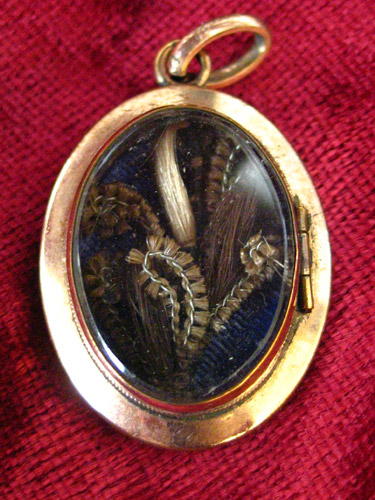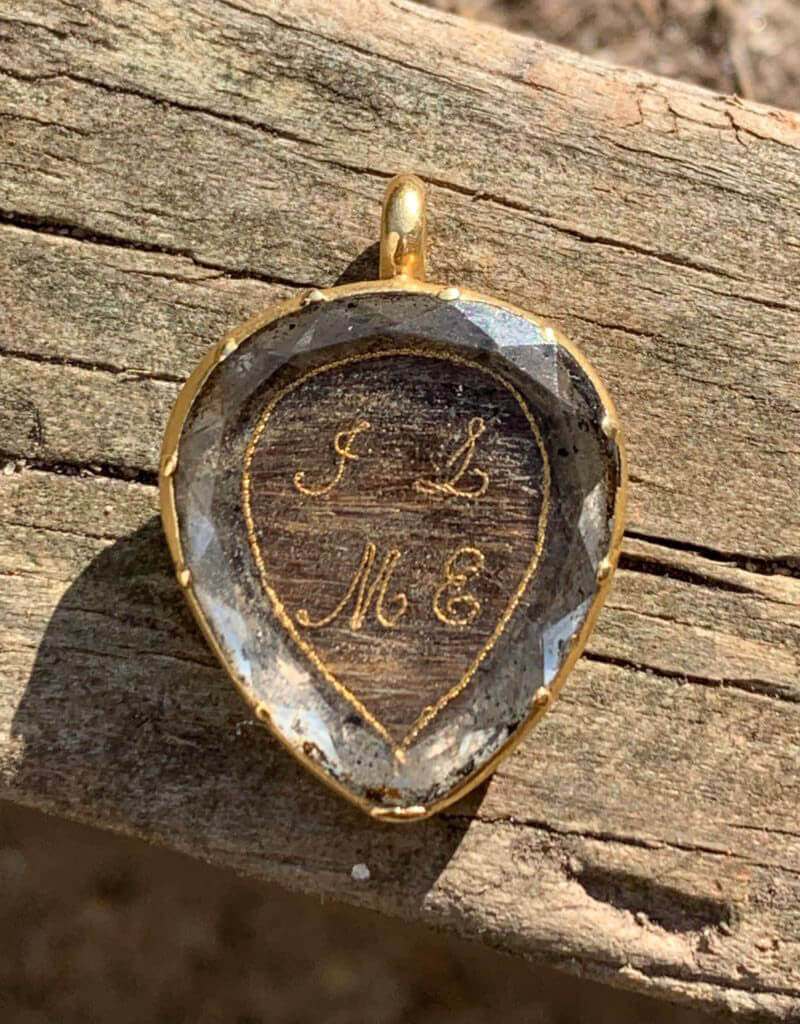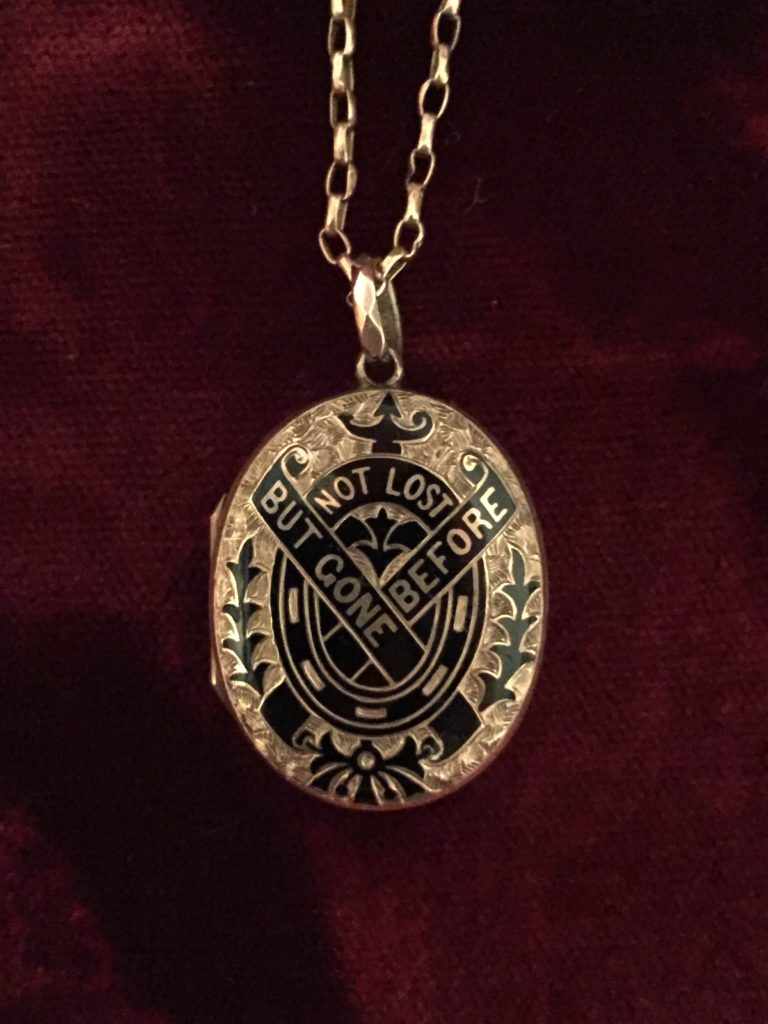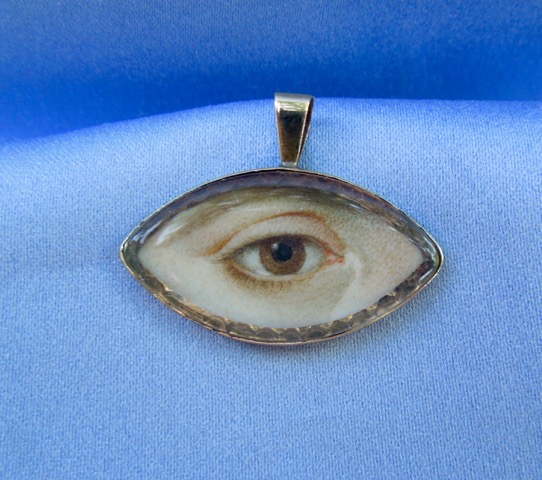Swiss Hairwork Locket, Mid 19th Century
The Swiss and German hairworking industries produced remarkable three dimensional hairwork and memorial art, as the above example shows. From Switzerland, the style of the hairwork is different than the conventional hair art of its time. The locket itself is built around the hair art and serves the purpose of displaying it, rather than being hidden away. Due to the larger size of the hair, it isn’t hidden away, but worn for display outwardly in a glass compartment. There are four different kinds of hair in this locket, all woven around wire in organic designs.
Folk at and sentimentality are both linked and incredibly personal. Distinctions of what can be folk art and a professional jewel or token of sentimentality are access to materials and level of skill. Otherwise, the nature of sentimentality exists in a paradigm of fashion.
Individuals can create a jewel from the simplest of elements, as long as the materials are accessible and malleable. This is why hair is so important as a material of sentimentality. From samplers that were created in the 18th and 19th centuries, to memorials and immortals, hair was shown to be a material that could build three-dimensional environments or incorporate with other materials. This, in effect, weaves the hair with a sentimental token of affection (be it a jewel or an image) that locks in the sentimentality of the person or family forever. Here, we can see this with the Swiss locket. The hair is woven over a wire skeleton in a floral motif, showing several types of hair. The setting is basic material and the locket itself is an alloy. None of these elements would be hard to procure in the 19th century, bringing the focus back onto ‘folk art’. Indeed, even the locket, with its large opening for placing of a token of affection, could be purchased and customised in the home. Was this the conceit of the jewel? We may never know, but all the right elements are in place for a jewel that was made by the combined family unit. For more on these, please view the further reading links below.
From a cultural perspective, one must ask what kinds of factors would lead to the creation of a piece like this beyond the basic desire to keep a token of love. Religion is often the key factor, beyond fashion, to dictate the way a person or family shows their sentimentality. At its most basic level, jewels created under a reformed variation of Christianity, changed (and challenged) the perspectives of Catholicism, leading to the Age of Enlightenment, where science and knowledge factored around the self. Jewels created under these societies have an immediacy in representation, as the person who has passed on or is being remembered is the singular person depicted in the jewel (or worn in, with hairwork).
Roman Catholic societies, while not exclusive to their traits, put the focus of death and remembrance on the Holy Trinity. The focus here turns to mourning being shown by the welcoming in of the soul to heaven, or entering the heart of Jesus.
The Holy Roman Empire dominated much of Europe up until the 19th century, and its dominance maintained throughout many modern art styles, such as the Baroque and Rococo, where much of the art and design flourishes instilled the imposition of Devine grandeur upon a society that could not afford it.
But how does this relate to the person? In this piece, we see see a jewel created after the Swiss civil war in 1847, involving Catholicsim, and into the creation of a Swiss federal state. From a geographic point of view, Switzerland sat in between the Holy Roman Empire and France, while also being a popular travel destination for a mobile society (particular during a young man’s ‘Grand tour’). The external influences cannot be overstated, from foreign fashion, to the nature of the person which would present themselves in this fashion. Switzerland has no official religion, so the elements of folk art representing the person in a simple way gives this locket a meaning and a reason for being.
Further Reading
> Just a Sample
> Hair Wreath / Art
> 1915 Needlework Mourning Sampler
> 1914 Memorial Sampler
> English 1892 Mourning Needlework Sampler
> 1892 Mourning Needlework Sampler
> 1886 Mourning Needlework Sampler
> Mourning Sampler with Photograph, c.1880
> 1858 Mourning Needlework Sampler
> 1855 Needlework Mourning Sampler
> 1843 Mourning Needlework Sampler
> 1840 Mourning Needlework Sampler
> 1834 Mourning Sampler
> 1797 Mourning Sampler
> Mourning/Sentimental Needlework and Art
Dedication: M.G (age 22)







